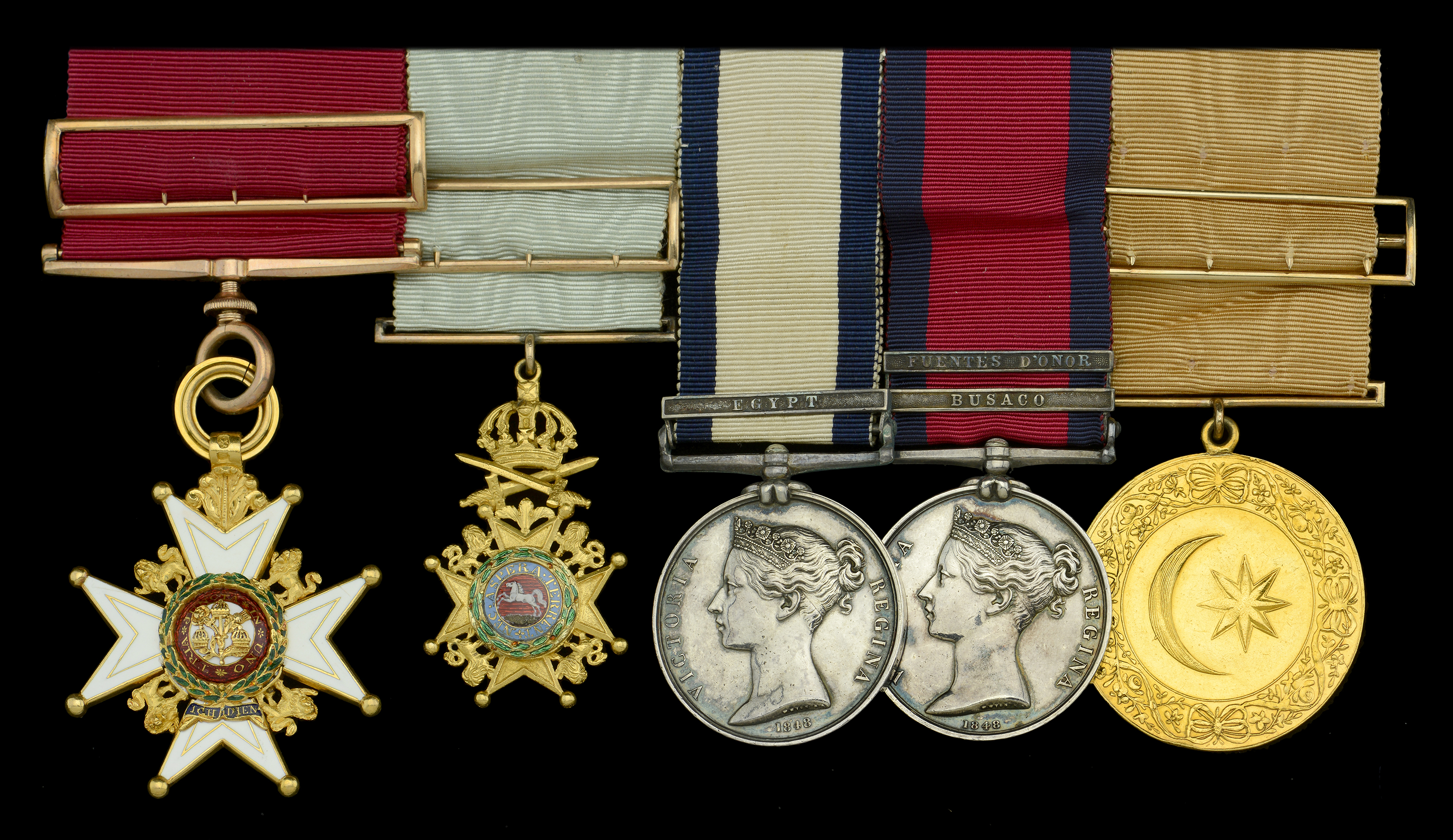The magnificent and unique C.B., K.H. Napoleonic War group of five awarded to Colonel Sir John Morillyon Wilson, 1st Foot, later Major of Chelsea Hospital, thirteen times wounded during his service in the Royal Navy and the Army, in the Peninsula and in North America where he was desperately wounded at the battle of Chippewa and his life saved by a native American woman before he was taken prisoner The Most Honourable Order of The Bath, C.B. (Military) breast badge in 22 carat gold and enamels, hallmarked London 1815, maker’s mark ‘IE’ for John Edwards, complete with original swivel-ring wide suspension and gold ribbon buckle; The Royal Guelphic Order, K.H. (Military) Knight’s breast badge with swords, gold and enamels, complete with gold ribbon buckle; Naval General Service 1793-1840, 1 clasp, Egypt (J. M. Wilson, Midshipman.); Military General Service 1793-1814, 2 clasps, Busaco, Fuentes D’Onor (Sir J. M. Wilson, Capt. 1st Foot); Sultan’s Gold Medal for Egypt 1801, 3rd class gold medal, 43 mm, fitted with contemporary straight gold bar suspension and gold ribbon buckle, minor enal chips to wreaths on the first two, otherwise generally good very fine or better and an exceptional group (5) £24,000-£28,000 --- Importation Duty This lot is subject to importation duty of 5% on the hammer price unless exported outside the UK --- --- Provenance: Dix Noonan Webb, November 1996. John Morillyon Wilson served as a Midshipman in the Navy for nearly six years. He was employed on the coast of Ireland during the Rebellion in 1798, as well as in the expedition to the Helder in 1799 and Egypt in 1801, where he received a medal from the Captain Pasha for having saved the lives of a boat’s crew belonging to a Turkish man-of-war. He received three wounds whilst as a Midshipman, the last being a severe wound to the head causing total deafness, in consequence of which he was invalided, and quitted the Navy in 1803. His health being restored, Wilson joined the 40th Foot in 1804, before moving to the 63rd Foot in January 1807. Later that year he was a Captain in the 1st Foot (Royals), serving with the 3rd Battalion at Walcheren in 1809, where he was again wounded twice leading the grenadier company during the assault on Flushing. In 1810, he was brought before court martial for using language ‘subversive to discipline, and disrespectful to the character of Colonel Barnes,’ his commanding officer. Although acquitted of conduct unbecoming of a gentlemen, he was found guilty of using language that was disrespectful and sentenced to a public reprimand. He afterwards served in the Peninsula, and was in the battles of Busaco, the retreat to the lines of Torres Vedras, and at the actions of Pombal, Redinha, Condeixa, Casal Nova, Foz d’Arouce, and Sabugal, the blockade of Almeida, and battle of Fuentes D’Onor. In 1812 he joined the 2nd Battalion Royals in Canada, and was in the attack made on Sackett’s Harbour and Great Sodus, where he received a severe bayonet wound. He was also in the actions at Fort Niagara, Black Rock, Buffalo, and the battle of Chippewa. The battle of Chippewa was the first major engagement between Major-General Jacob Brown’s Left Division of the United States Army and the Right Division of Upper Canada led by Major-General Phineas Riall. Both commanders committed a brigade onto the plain of Chippewa during the afternoon of 5 July 1814. The three British units included the 1/1st Foot, 1/8th Foot and 100th Foot. The 1st Foot formed the centre of the British line, and its pre-battle reported strength was 500 all ranks under Lieutenant-Colonel John Gordon. Heavily engaged during the battle, the Royals suffered one officer and 77 other ranks killed, and 8 officers and 144 other ranks wounded. Two officers were taken prisoner and 77 soldiers were reported as missing. Captain John Morillyon Wilson was one of the two severely wounded officers that were taken prisoner. He had been wounded seven times and left for dead on the battlefield. A native armed with a knife then attacked him, but Wilson killed his attacker and was then kept alive by a native woman from a nearby village before being taken prisoner. He was exchanged in February 1815. During his career in the two professions he received 13 wounds, and it is said carried two balls lodged in his body to the grave. The Brevet rank of Major, and that of Lieutenant Colonel, was conferred on him for his conduct at Buffalo and Chippewa. He was placed on half pay in 1822, promoted Colonel in January 1837, and created a Companion of the Bath on 19 July 1838. Colonel Wilson was Gentleman Usher of the Privy Chamber for nearly 20 years to Queen Adelaide. He was appointed Adjutant of the Royal Hospital, Chelsea on 16 November 1822, and Major of the same establishment on 14 July 1855, which position he held until his death there in 1868.





